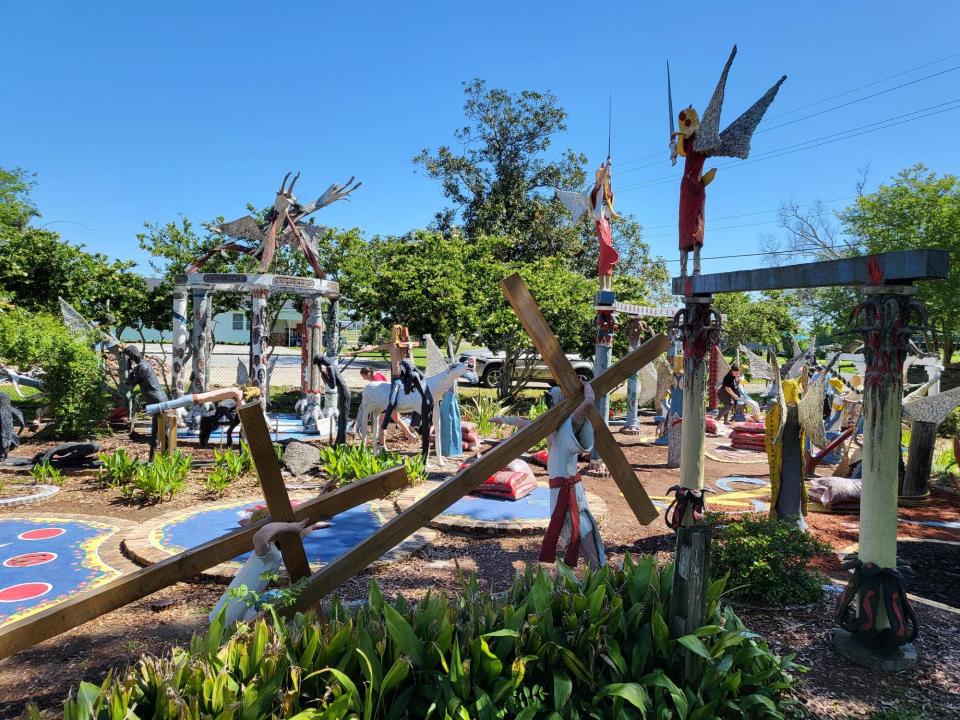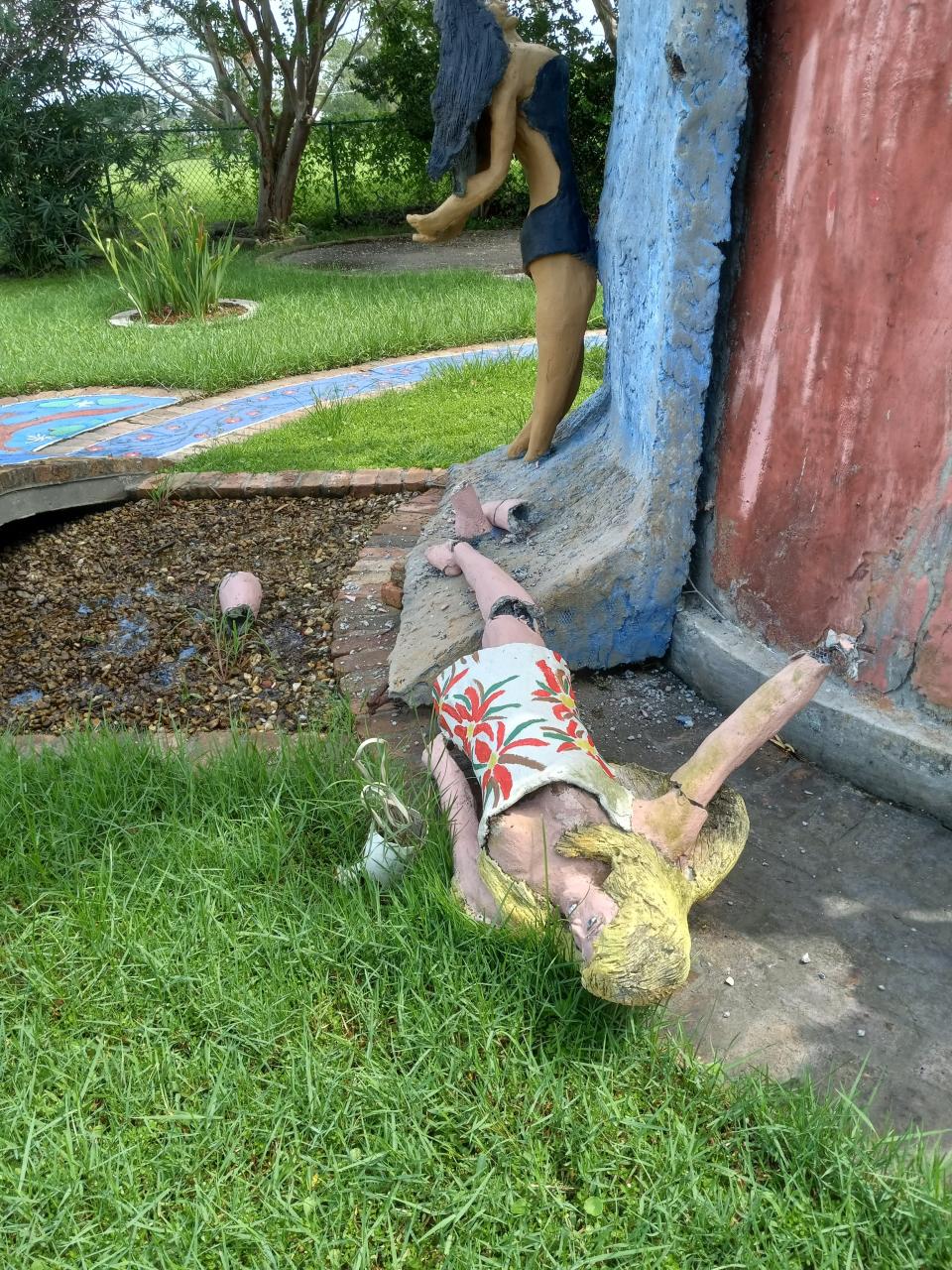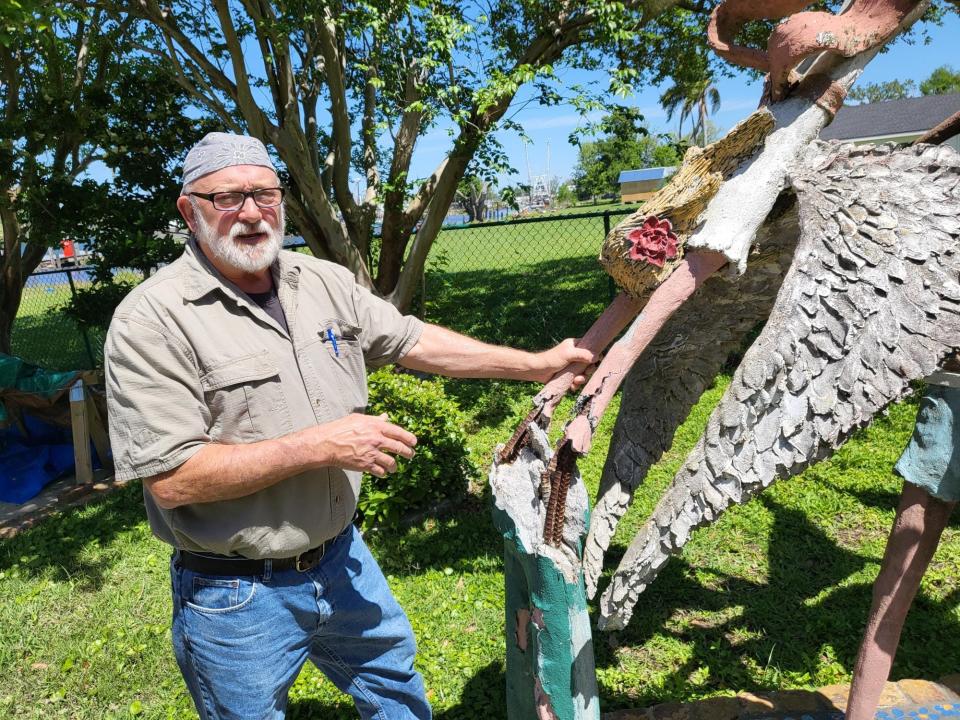Crews work to restore sculptures by reclusive Chauvin artist in Nicholls State garden
A reclusive artist's sculpture garden in Chauvin is being restored after vandals and storms have chipped it away.
Thirteen people gathered at the Kenny Hill Chauvin Sculpture Garden, 5337 Bayouside Dr., April 13 to remove broken down cement benches, throw down fresh mulch, and fill in holes with dirt. Among them was Greg Elliott. He and two other professional restorationists are working to repair the damages to the sculptures caused by Hurricane Ida and vandalism, a task he said likely will take nearly two years.

Gary LaFleur, head of the Center for Bayou Studies at Nicholls State University, said it's worth it to preserve this one-of-a-kind art.
"It's like when you see something and you know there's only one of it in the world, you just get a feeling that it has to be taken care of," LaFleur said.
The Artist
The sculpture garden was created by Kenny Hill who moved to the area from Springfield in 1988 after a divorce. Notoriously media shy, he became known as a recluse. Andrew Cuneo, 36, grew up near Hill. He said the artist was looking for a quiet place to start anew.
"He relocated here and found a place where he could live quietly and apply his trade," Cuneo said. "He was a good soul. For us that were in close proximity to him, you couldn't ask for a better neighbor. He wanted nothing from nobody, and he was making this for him."
His father, Errol Cuneo, befriended Hill and trusted his sons around him. Cuneo said he remembered one year when his father and Hill exchanged gifts.
One Thanksgiving the temperatures were dipping dangerously low. Hill lived a life of simplicity with no electricity, and only had a wood-burning stove to stay warm. Errol gave him his bomber jacket to stay warm.
"And on Christmas day that year, we invited him over to eat with us, and he showed up with a dog," Cuneo chuckled. "And I don't know if my parents knew that, but it ended up being our dog for 12 years."
Her name was Lucy.
Hill worked as a bricklayer and would leave for work for extended periods of time, and when he returned he would work on his sculptures in the side-yard. He had a small house near the bayou and paid $150 a year in rent. The front and the side-yard not used for sculpting were wildly overgrown while Hill lived there.
The Art
The statues are mostly biblical in nature. Most are of angels, with a few of Jesus. In the back of the yard is a large lighthouse with statues built into the walls. They include soldiers raising the flag at Iwo Jima, girls bathing at a waterfall, a drunken cowboy riding a horse, and more.
"I thought it was a putt-putt golf place," LaFleur said, describing the first time he ever visited. He never met Hill. "I saw Kenny look at me through the window. He just let me walk around."
Hill was evicted in 1999 when the Parish Government took issue with the vegetation. While he was away at work, crews were sent to clean up the sites. Hill returned to his normal $150 rent, plus a large bill for the clean up. Hill was seen leaving the property with three items:
"The day he walked away from it was in January of 2000. In fact my dad was driving me and my brother home and right up the street here we saw Kenny, he had the jacket that my dad had given him on his back, a walking staff and a backpack on," he said.
His father offered to help Hill out, but he was set on leaving. The garden has been spruced up since Hill left. The properties were purchased by the Kohler Foundation and were donated to Nicholls.
Restoring the Damage
Hill's former home was vandalized shortly after his departure, and more recently the sculptures were. Around July 2022, vandals damaged an angel, smashed the legs from one of the bathing women, and uprooted the statue of a little girl peering into a pond. Later, in April, vandals threw the little girl into the bayou.

The college received a $75,000 grant from the Ruth DeYoung Kohler Legacy Fund to aid in the repairs. It's administered by Ruth Arts, a national philanthropic group based in Milwaukee.
Elliott is one of three restorationists who are working to repair the statues, and said he has his work cut out for him. The vandals did a number on the statues, but time and weather did worse, he said. The sun has leached the colors from the paints. Hurricane Ida bent a number of the statues. Angels are bent over backwards, split in two by the wind exposing their rebar entrails. The lighthouse survived the hurricane, but time itself is threatening it. The rebar inside is aging and expanding, cracking through the brick.

Folk artists like Hill don't use conventional methods of creation. As Cuneo said, Hill had the mind of an artist and the hands of a stonemason. It showed in Hill's creations, Elliott said. Moving through his statues he showed where Hill developed consistency in his method.
"It's interesting to me that I can see the later pieces because his knowledge of the process is more consistent. I don't know if it's better or worse, but it's much more consistent," Elliott said.
He's starting with the statues at the front and working his way to the lighthouse. The lighthouse is the largest undertaking, as portions will have to be rebuilt and large machinery necessary for the job is likely to sink into the ground and get stuck. As a restorationist, Elliott and the others have to find the balance between how the art originally looked and the intent of the artwork.
"Is this a proper knee and ankle structure? No. I mean Kenny's anatomy was nothing short of, naive. I mean, if your arm did that, listening to a shell, you'd rush yourself to the hospital," Elliott said pointing to one of Hill's self-portrait pieces.
He said even the greats like Michelangelo had their shortcomings. The great Italian sculpture knew little about women's anatomy, Elliott said, but if someone were to focus on it they'd miss the point of the artwork,
"I'm of the ilk that - and some people get all wrapped up in the absolute correct accuracy of it - but that's not what drove Kenny," he said.
The Chauvin Sculpture Garden is open 8 a.m. to 5 p.m. Monday through Sunday. The Nicholls Art Studio is free and open to the public on Saturdays and Sundays from 11 a.m. to 4 p.m. or by appointment. To make a donation, call Nicholls' Division of Art at 448-4597. To learn more, visit https://www.nicholls.edu/folkartcenter/folk.html.
This article originally appeared on The Courier: Nicholls State University restores sculptures by reclusive artist

